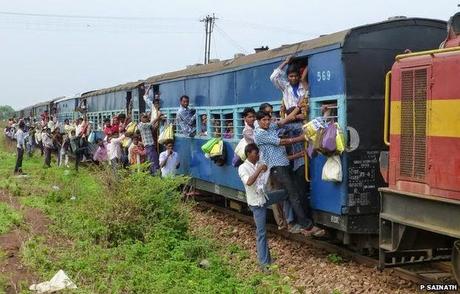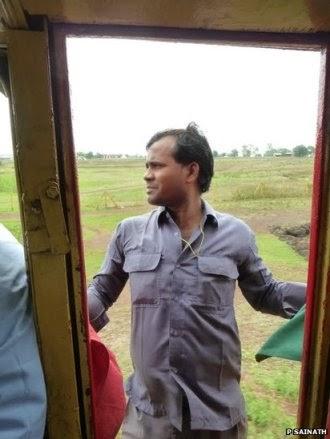
When Kanhaiyalal Gupta jumped off from the engine driver's cabin with a pair of red and green flags in his hands, we got off the slowing train too. What we did not expect was for him to shoot off across the next 200 metres like a sprinter. We ran behind him, stumbling on the uneven surface. Mr Gupta darted towards an unmanned railway crossing and waving his red flag, quickly shut and locked the gate there. Then he turned towards the train and waved the green flag. The train moved forward, passed the locked gate - and stopped again. Mr Gupta opened the gate and raced back to the driver's cabin, with us closely behind. He could do this up to 16 times over a distance of 68km (42 miles), on a one-way journey."
 It's what I do. I'm
the mobile gatekeeper," he says. Some 11,500 of the more than 30,000
railway crossings in India are unmanned. Nearly 40% of train-related accidents
and two-thirds of deaths on railway tracks - usually happens when people are
crossing them - take place at these unmanned crossings. The railways' response
has been to shut down as many unmanned crossings as it can rather than staff
them with gatekeepers. Or to create 'mobile gatekeepers' like Mr Gupta to do
the work of many.
We are traveling on the
crowded Dhamtari passenger train in the central state of Chhattisgarh. The slow
narrow gauge train is better known as the "labour train" for it
ferries hundreds of migrant workers from nearby villages to the state capital,
Raipur, in search of work. It's a nine-station journey from Dhamtari to
Telibandha, the last narrow gauge stop in Raipur. Only two or three of some 19
railway gates on the route are manned. "My job is to open and shut the
gates. I enjoy my work," says Mr Gupta, who earns less than 20,000 rupees
($331; £205) a month ~ and Kanhaiyalal Gupta says he loves his work
In the early stations on the
route, a "mobile gatekeeper" can board one of the rear coaches after
seeing the train through at one of the railway gates. With the train yet to
fill up, he can sit comfortably. As the train nears Raipur, though, he hasn't a
chance of squeezing in. So he has to run up to the driver's cabin and stand
there till the next railway gate.
India's state-run railways
runs more than 12,000 trains, carrying some 23 million passengers daily. The
"mobile" role Mr Gupta has been given is a way of keeping recruitment
down, unions say. Mr Gupta, is reported to be totally focused on his work, readying
for the next gate ~ and many of us complain that we
are doing difficult work daily.
It's what I do. I'm
the mobile gatekeeper," he says. Some 11,500 of the more than 30,000
railway crossings in India are unmanned. Nearly 40% of train-related accidents
and two-thirds of deaths on railway tracks - usually happens when people are
crossing them - take place at these unmanned crossings. The railways' response
has been to shut down as many unmanned crossings as it can rather than staff
them with gatekeepers. Or to create 'mobile gatekeepers' like Mr Gupta to do
the work of many.
We are traveling on the
crowded Dhamtari passenger train in the central state of Chhattisgarh. The slow
narrow gauge train is better known as the "labour train" for it
ferries hundreds of migrant workers from nearby villages to the state capital,
Raipur, in search of work. It's a nine-station journey from Dhamtari to
Telibandha, the last narrow gauge stop in Raipur. Only two or three of some 19
railway gates on the route are manned. "My job is to open and shut the
gates. I enjoy my work," says Mr Gupta, who earns less than 20,000 rupees
($331; £205) a month ~ and Kanhaiyalal Gupta says he loves his work
In the early stations on the
route, a "mobile gatekeeper" can board one of the rear coaches after
seeing the train through at one of the railway gates. With the train yet to
fill up, he can sit comfortably. As the train nears Raipur, though, he hasn't a
chance of squeezing in. So he has to run up to the driver's cabin and stand
there till the next railway gate.
India's state-run railways
runs more than 12,000 trains, carrying some 23 million passengers daily. The
"mobile" role Mr Gupta has been given is a way of keeping recruitment
down, unions say. Mr Gupta, is reported to be totally focused on his work, readying
for the next gate ~ and many of us complain that we
are doing difficult work daily. With regards – S. Sampathkumar 22nd Sept. 2014
Credits : the info on mobile gatekeeper extracted from a report in BBC.

